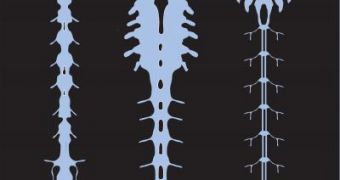Recently unearthed remains of a creature that lived about 520 million years ago are so well preserved that scientists have been able to map the animal's entire nervous system.
By the looks of it, this creature's remains are the oldest to still contain a complete nervous system that have thus far been discovered.
Writing in the latest issue of the journal Nature, researchers detail that this creature was discovered in southwest China.
It measures about 3 centimeters (a little over an inch) in length, and its body was made up of several segments.
Investigations have revealed that it belongs to a group of extinct marine arthropods known to the scientific community as megacheirans, which translates as “large claws.”
Thus, this creature and those related to it used to sport an impressive set of scissor-like appendages on its head, which was used either to grab hold of various things or to make head and tail of its surroundings.
The genus it belongs to is dubbed Alalcomenaeus, EurekAlert tells us.
Apparently, this animal's nervous system was surprisingly similar to that of the horseshoe crabs and scorpions that presently live in various parts of the world.
More precisely, the creature had three clusters of nerve cells, i.e. ganglia, that formed a brain, and which were fused together with ganglia in the body.
Based on this information, specialists have concluded that the forefathers of spiders, scorpions and other similar creatures branched off the family tree of arthropods about 500 million years ago, the same source reports.
“We now know that the megacheirans had central nervous systems very similar to today's horseshoe crabs and scorpions. This means the ancestors of spiders and their kin lived side by side with the ancestors of crustaceans in the Lower Cambrian,” researcher Nicholas Strausfeld with the University of Arizona explains.
“The prominent appendages that gave the megacheirans their name were clearly used for grasping and holding and probably for sensory inputs. The parts of the brain that provide the wiring for where these large appendages arise are very large in this fossil. Based on their location, we can now say that the biting mouthparts in spiders and their relatives evolved from these appendages,” he goes on to say.

 14 DAY TRIAL //
14 DAY TRIAL //